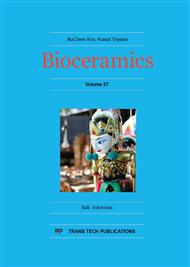[1]
N.B. Cramer, J.W. Stansbury, and C.N. Bowman. Recent advances and developments in composite dental restorative materials. J. Dent. Res. 90(4) (2011) 402–416.
DOI: 10.1177/0022034510381263
Google Scholar
[2]
J. Da Costa, J. Ferracane, R.D. Paravina, R.F. Mazur, L. Roeder. The effect of different polishing systems on surface roughness and gloss of various resin composites. J. Esthet. Restor. Dent. 19 (2007) 214-224.
DOI: 10.1111/j.1708-8240.2007.00104.x
Google Scholar
[3]
M. Jung, K. Sehr, J. Klimek. Surface texture of four nanofilled and one hybrid composite after finishing. Oper. Dent. 32 (2007) 45-52.
DOI: 10.2341/06-9
Google Scholar
[4]
A.D. Puckett, J.G. Fitchie, P.C. Kirk, J. Gamblin. Direct composite restorative materials. Dent. Clin. North. Am. 51 (2007) 659-675.
DOI: 10.1016/j.cden.2007.04.003
Google Scholar
[5]
S.B. Berger, A.R.M. Palialol, V. Cavalli, M. Giannini. Characterization of water sorption, solubility and filler particles of light-cured composite resins. Braz. Dent. J. 20(4) (2009) 314-318.
DOI: 10.1590/s0103-64402009000400009
Google Scholar
[6]
C. Poggio, M. Lombardini, S. Gaviati, and M. Chiesa. Evaluation of Vickers Hardness and depth of cure of six composite resins photo-activated with different polymerization modes. J Conserv Dent. 15(3) (2012) 237–241.
DOI: 10.4103/0972-0707.97946
Google Scholar
[7]
N. Hideo, S. Yasuhiko, and N. Masahiro. Restorative dental ceramic for crown composed of zirconia based nanocomposite. Japan; Science Link Japan. 54(3) (2006) 78-82.
Google Scholar
[8]
N. Djustiana, Z. Hasratiningsih, B.S. Purwasasmita, E. Karlina, R. Febrida, V. Takarini. Synthesis of ZrO2-Al2O3-SiO2 and ZrO2-CaO-SiO2 as Filler for Restorative Dental Materials using Sol-Gel Method. Prosiding 9th International Dental Federation-Indonesia Dental Association Joint Meeting Proceeding Book. (2013).
DOI: 10.4028/www.scientific.net/kem.696.74
Google Scholar
[9]
C.P. Bergmann, A. Stumpf. Dental ceramics microstructure, properties, and degradation. Heidelberg; Springer. 3 (2013) 15-23.
Google Scholar
[10]
C. Piconi, G. Maccauro. Zirconia as a ceramic biomaterial. Biomaterials. 20 (1999) 1–25.
DOI: 10.1016/s0142-9612(98)00010-6
Google Scholar
[11]
I. Denry, J.R. Kelly. State of the art of zirconia for dental applications. Dent Mater. 24 (2008) 299–307.
DOI: 10.1016/j.dental.2007.05.007
Google Scholar
[12]
M. Guazzato, M. Albakry, S.P. Ringer, M.V. Swain. Strength, fracture toughness and microstructure of a selection of all ceramic materials. Part II. Zirconia based dental ceramics. Dent Mater. 20 (2004) 449–56.
DOI: 10.1016/j.dental.2003.05.002
Google Scholar
[13]
A. Shenoy, and N. Shenoy. Dental ceramics: an update. J. Conserv Dent. 13(4) (2010) 195–203.
DOI: 10.4103/0972-0707.73379
Google Scholar
[14]
S.B. Mitra, D. Wu, and B.N. Holmes. An application of nanotechnology in advanced dental materials. Journal of the American Dental Association. 134(10) (2003) 1382–1390.
DOI: 10.14219/jada.archive.2003.0054
Google Scholar
[15]
H. Lu, Y.K. Lee, M. Oguri, and J.M. Powers. Properties of a dental resin composite with a spherical inorganic filler. Operative Dentistry. 31(6) (2006) 734–740.
DOI: 10.2341/05-154
Google Scholar
[16]
H.N. Akbar. K. Moharamzadeh, D.J. Wood. and R. Van Noort. Relationship between color and translucency of multishaded dental composite resins. International Journal of Dentistry. 2012 (2011).
DOI: 10.1155/2012/708032
Google Scholar
[17]
A.U. Yap. Effectiveness of polymerization in composite restoratives claiming bulk placement: Impact of cavity depth and exposure time. Oper Dent. 25 (2000) 113–20.
Google Scholar
[18]
R.R. de Moraes, L. Gonçalves, S. de, A.C. Lancellotti, S. Consani, L. Correr-Sobrinho, M.A. Sinhoreti. Nanohybrid resin composites: Nanofiller loaded materials or traditional microhybrid resins? Oper Dent. 34 (2009) 551–7.
DOI: 10.2341/08-043-l
Google Scholar
[19]
M. Rosentrit. A focus on zirconia : An in vitro lifetime prediction of zirconia dental restorations. Dissertation. Faculty of Dentistry. University of Amsterdam. (2008).
Google Scholar
[20]
J. Park. Bioceramics Properties, Characterization, and Applications. New York: Springer. 7 (2008) 142.
Google Scholar


